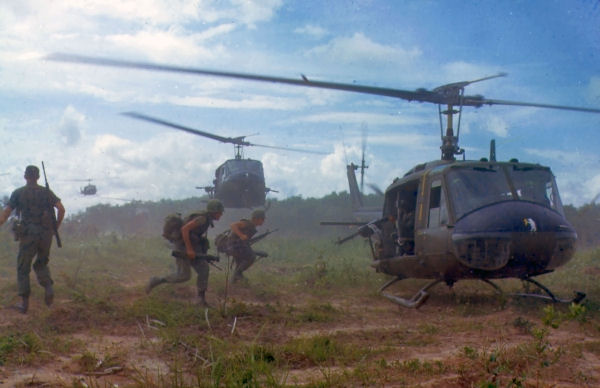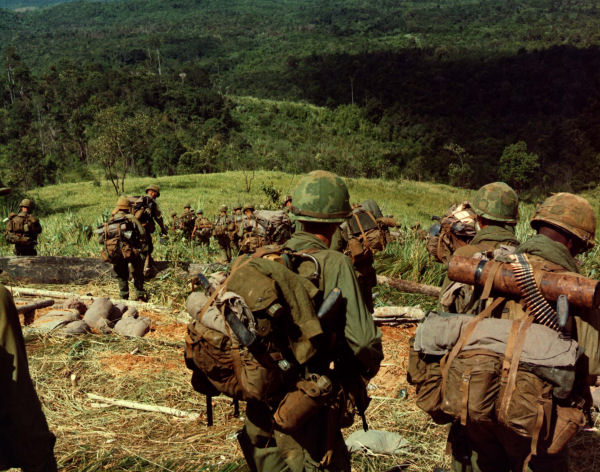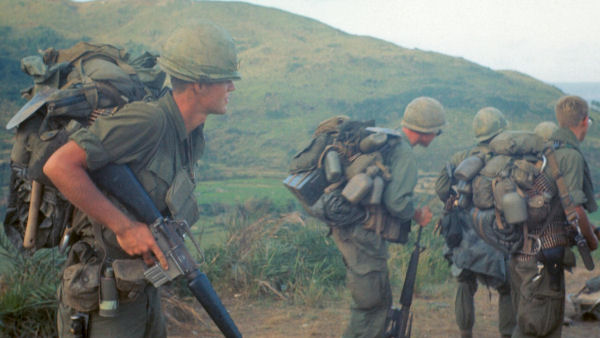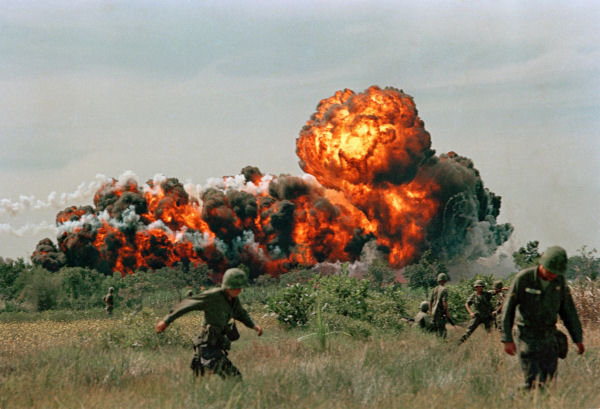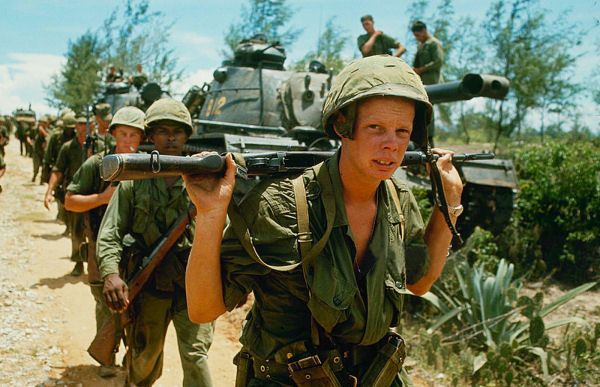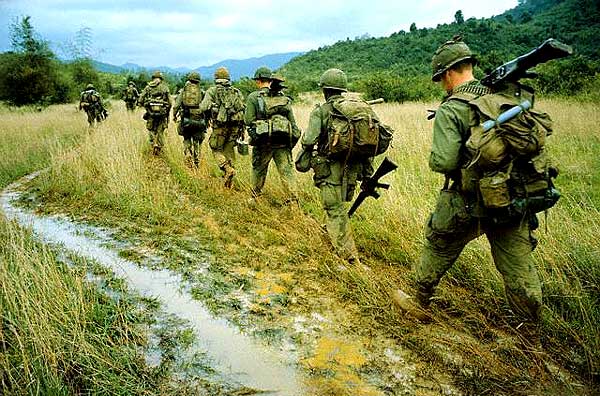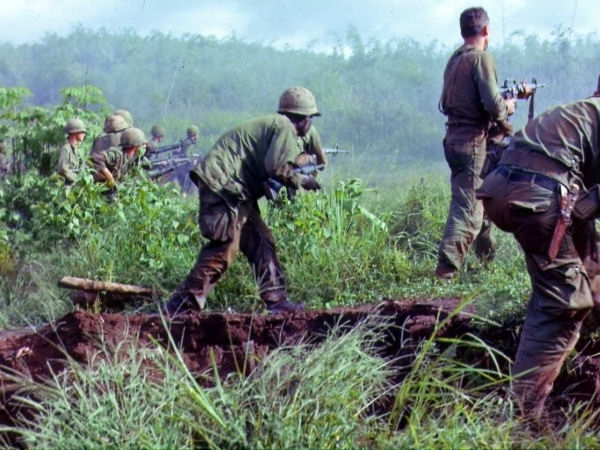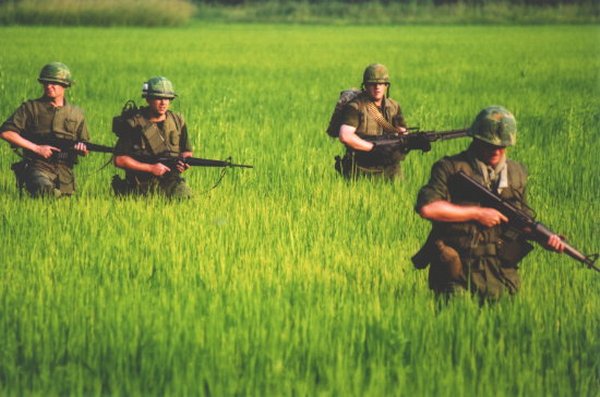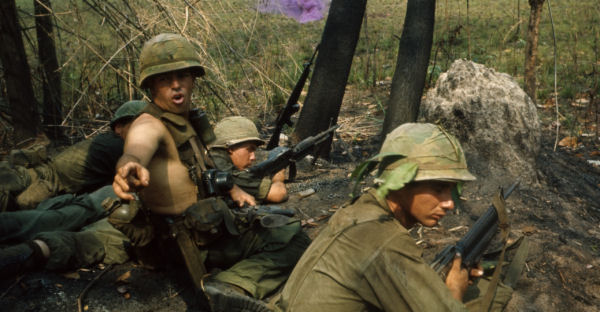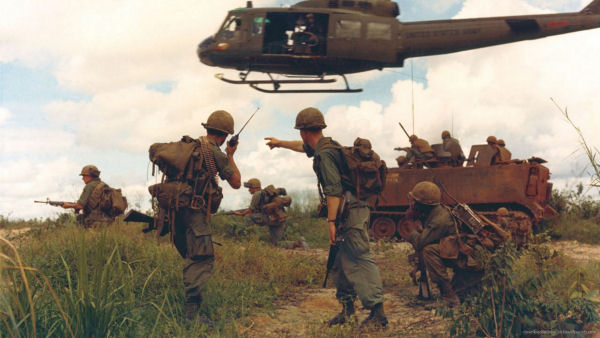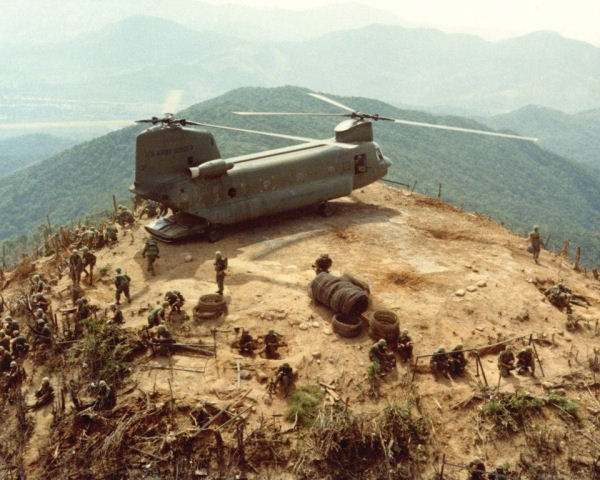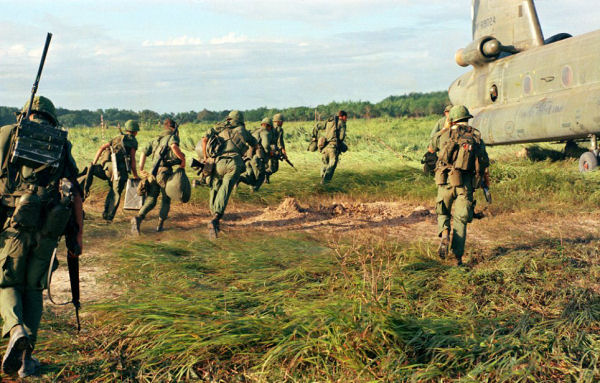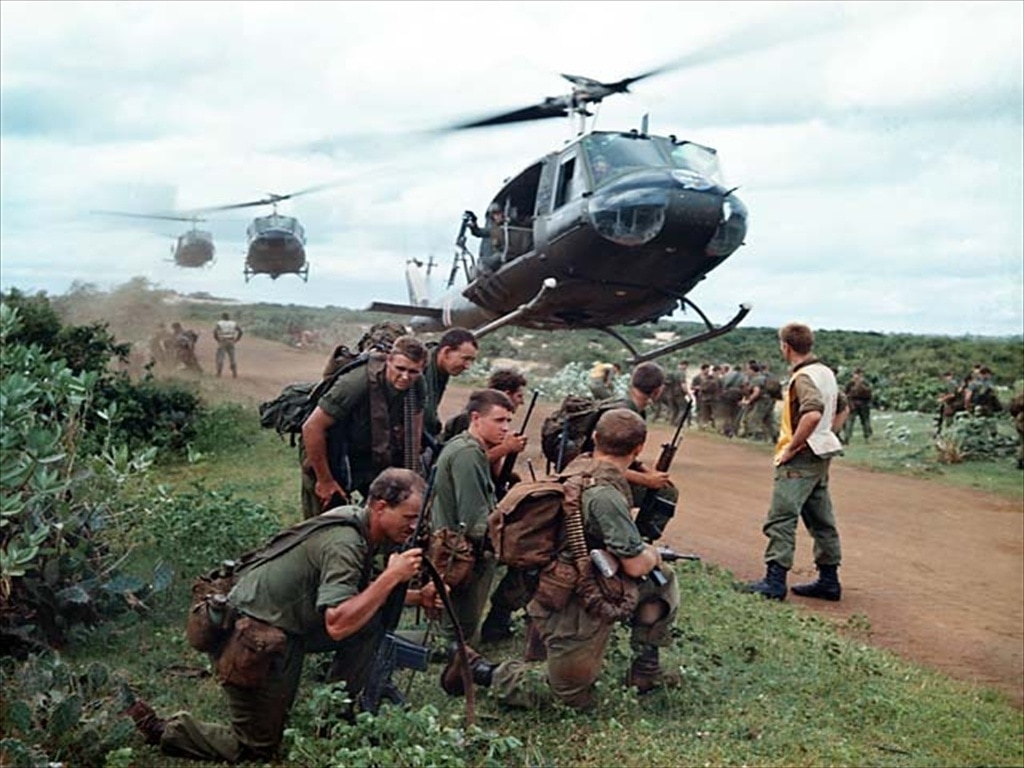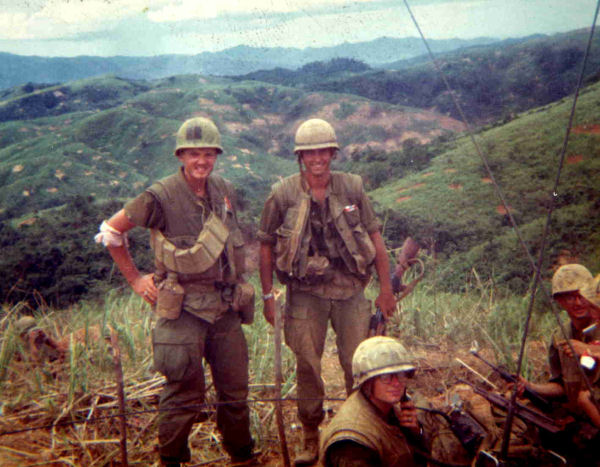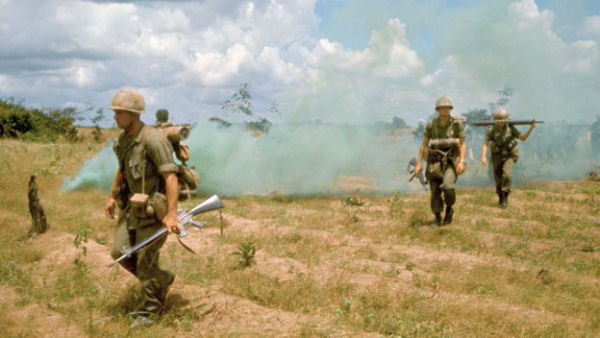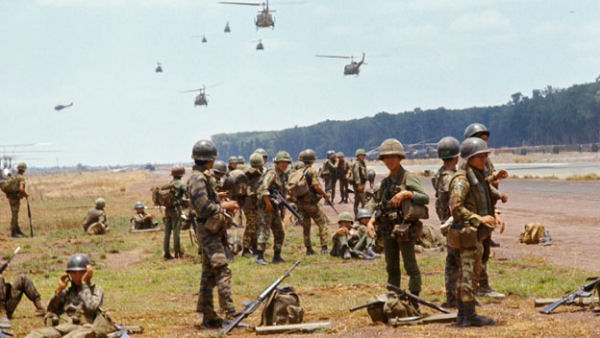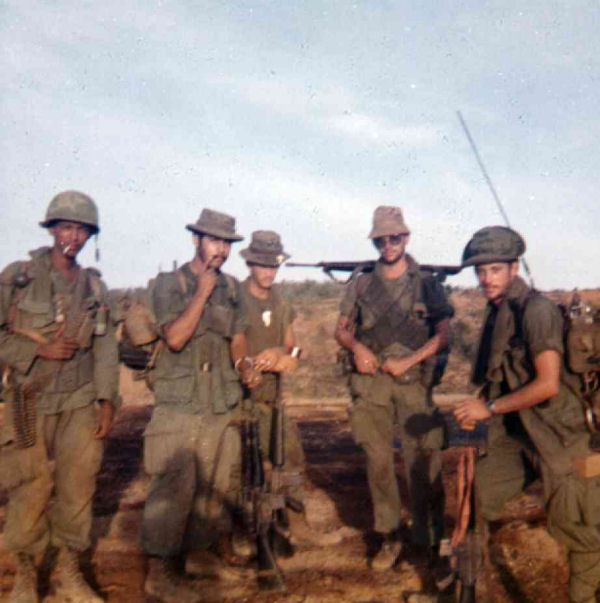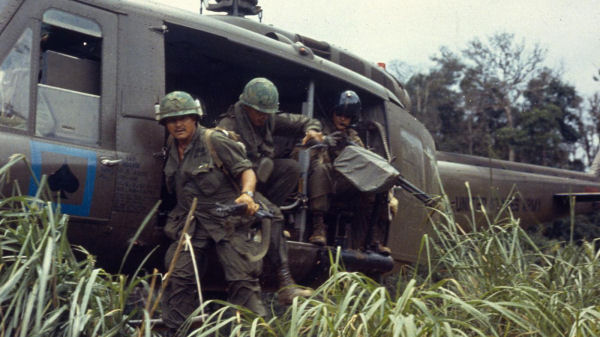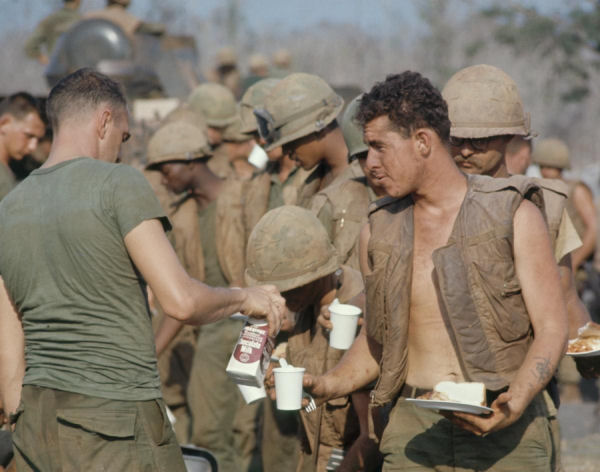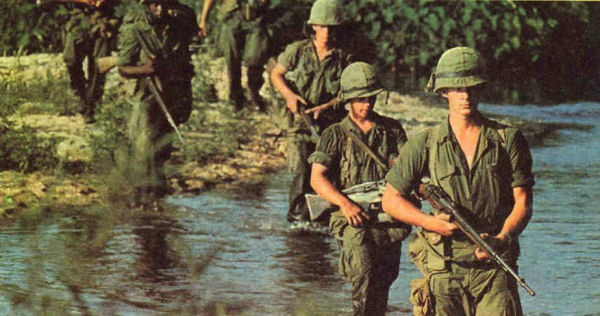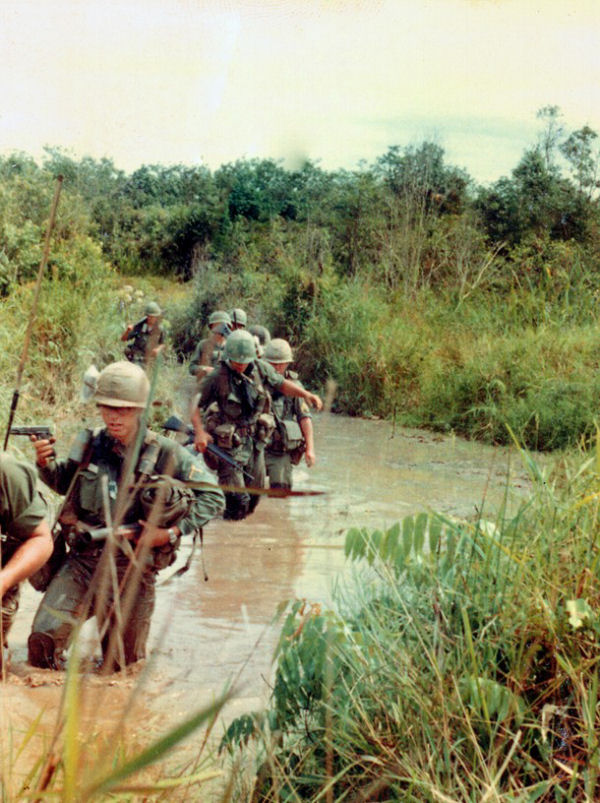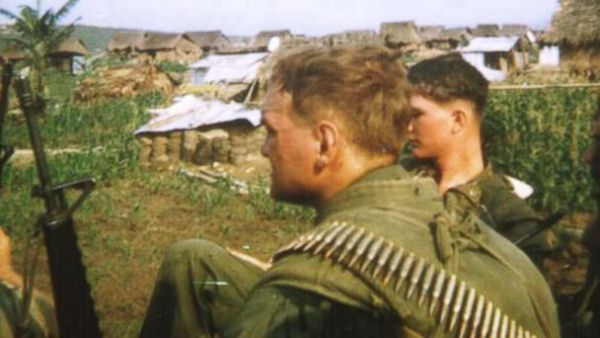|
BADDAWG's guide to US VN uniforms:
SHOULDER PATCH We wore the color patch into combat when I was there as an esprit d' corps thang; some time much later in the 70s a "subdued " black 1 on a green background was issued after the Pentagon decided, the color patch did not present a "combat image!" The green on the BIG RED ONE patch is a very shiny olive green/drab, supposedly the same as was worn in WW I. The 1 was that vibrant blood red! JUNGLE BOOTS Almost indestructible BLACK man made material for the soles, with BLACK leather lower, and a very shiny light green nylon upper with black leather edges, and brass lace holes painted black. In real life, the jungle boots quickly became pinkish white, or rust red/white as the boots lost their black finish, and the constant rubbing of jungle turned the leather off white, and the rust red dirt changed the color. The nylon green uppers became a pink green or a rust red green from the dirt too. This also happened to the issue black leather REAL WORLD combat boots worn in the jungle, plus a green mold started to grow on them, and they would eventually rot and come apart. NEW POPLIN JUNGLE FATIGUES AND JUNGLE HATS These were solid dark, olive drab in color, rapidly fading to the soft light gray-green that the REAL WORLD cotton fatigues also turned with wear. The heavy cloth cotton REAL WORLD fatigues were always faded out when worn in the RVN unless it was by the NAVY, who got them issued new as a duty uniform. Reason? This was the uniform most often worn by soldiers, marines and airmen all around the world. When new it is a darker shade than that worn by the Brits and Aussie/Kiwis. All webbing is a dark shade of green when new, and even when used a bit the color remains. In the RVN, the webbing, like everything else soon turned pinkish gray-green with use and exposure to the countryside. Rifle slings were a lighter shade of green, even when new, and also got the same pinkish graygreen color with time. Web gear metal fitting was black painted brass, and soon lost its paint in the field. The steel pot is a very flat olive green in color when newly painted. Ditto for the helmet liner worn under it (paint mixed with sand to achieve this in Real Life). Straps are a faded gray-green, soon to become pinkish red-gray green. About the ONLY TIME we wore the chinstraps fastened was on parade or when using the pot as a bucket. Otherwise, the strap was kept fastened at the back of the helmet. Camouflage helmet covers were various shades of mottled autumn browns on one side, and various shades of mottled greens on the other. With wear, the green faded to a lighter shade, then turned pinkish gray green like everything else. Hair was shaggy in the field, side burns were common, and dirty, but we shaved daily to avoid infections if we got hit in the face. Moustaches were worn BIG, mostly handle bars, some Fu Manchus, some semi-Hitler jobs. There were almost as many Joe College crew cuts in the field as longer hair, Ammo bandoliers came from metal ammo boxes and were a lighter shade of green than the web gear. Ditto for claymore bags. M-60 spare barrel cases were a shiny OD plastic with black zippers. GI Pistol holsters ( hip or shoulder) were either black leather, or a tan natural leather color. Pistol ammo pouches were a slightly different shade of OD webbing when new, but quickly faded to match other webbing Bayonet-knives had dull black plastic handles with BLACK METAL BLADES AND FITTINGS! Only a slender silvery line revealed a cutting edge on the blades. Bayonet self-sharpening sheathes were dull OD plastic with metal fittings black. Machetes had black handles and very long blue-black metal blades with only a silvery sharpened edge showing along the bottom, unless custom ground to be double edge. Sheath is OD canvas with flat black metal fittings. Tie downs for holsters and sheathes were natural tan leather., but were often replaced with black nylon bootlaces. Protective mask cases were the same color as other web gear when new, and when faded, but rarely went to the field with us. Flak jackets were soft, heavy, thick ballistic nylon, as were the drawers. Shiny dark OD color when new, faded rapidly out to a tan-ugly light green, often greasy with sweat stains, and other crud, as well as pinkish gray-green. We never wore them in the Big Red One-too hot, too heavy, not enough protection from AK’s and etc. Some A-CAV trooper wore them when riding their tracks, as did MPs on jeep duty. MP's Always wear the brassard on the left upper arm. The brassard has white letters MP on a navy blue, jet black or light OD background. Army brassards always have a shoulder patch on it, in colors or in a black design with a green background. Marine MP brassards are red and gold when colored and look like a WW II US Army MP brassard and are always worn on the left upper arm. Army MP's always have black pistol holsters when wearing webbing. Pistol ammo pouches are also black leather as is the baton carrier. The baton is always painted a shiny black. MP steel pots and helmet liners in rear areas and everywhere else were painted a shiny black, with large white MP on the front and either a solid red band connecting the MP to a unit patch on both sides for divisional MP's, or a red over white band in the same place for other MP's. Blood red always, camo covers were worn over these show pieces, which were, kept polished with floor polish! The non-divisional MP's always have a unit number on the left side of the helmet liner/steel pot, and the unit patch on the right side. Most non-divisional MP companies are independent units attached to higher HQ, and are numbered instead of OD lettered. Now in some MP battalions the companies and lettered A-D! To further confuse you numbered companies and lettered companies can be in the same battalion! SHOULDER PATCHES AGAIN! Since many soldiers went to the RVN more that one time, if they were in the army for more than two years, you will see some troops with a Big Red One patch on both shoulders, or another unit patch on the right shoulder (Combat arm literally!). Since I was in the Big Red One, and the 18th MP brigade too, I am entitled to wear either patch on my right shoulder! CLOTHING GI underwear came in three basic types; white cotton, OD cotton, and cotton/wool long johns(not worn in the RVN by even the most manly of manly men!) It consisted of gape front boxer shorts, and a T-shirt. NO WW II TYPE undershirts were issued in the 60s! OD under wear is originally dark, but it fades out to a lighter shade very rapidly, eventually turning a yellow tan color or a gray-green color. MOST soldiers and marines, never wore any underwear in the field or in base camp because it was hot! Underwear, like after shave and cologne, was donned ONLY when going to the vill to get screwed, blued and tattooed! GI SOCKS are made of cotton or wool. The cotton socks are black and worn with low quarter shoes, the wool socks, have a cushioned sole, are a light shade of OD that quickly fades out to a yellow tan color. BOOT SOCKS were worn by everyone in the field, and in base camp. BOOT SOCKS, were loaded with C-rations and tied to the soldier's web gear harness in the field for convenience and silence. These were also tied to the frame of the rucksack during air assaults. The cardboard boxes that the cans were packed in were tossed as awkward garbage. SUNGLASSES were issued to all troops, but not worn as they made it hard to see tripwires, and added to the risk of wounding in an explosion. STEEL POTS AGAIN! I almost forgot-the elastic band that goes around the outside of a steel pot and camo cover is also OD, and fades out to a gray green or an ugly yellow tan. Most often seen holding a squeeze bottle of bug repellent on the helmet, or a pack of cigarettes, or a first-aid dressing. The rear of the steel pot's camo cover, just above the buckled chinstrap SOMETIMES had eadership bars painted on it for quick recognition. This is a 1-2" tall and 1/2 " wide WHITE bar, vertical for all officers, horizontal for all NCOs. It could be BLACK, and often was BLACK! This was often times the only rank insignia worn in the field by officers and NCOs. ALL wound dressings were OD or green, with black lettering on gauze pad, and came in a waterproof packet. Each soldier carried at least one of these (for himself!) in a small web pouch. This is the pouch usually seen on the front of the web belt, or on the web shoulder straps. usually worn upside down on the shoulder straps. We did not normally carry sulfa powders, etc, to treat wounds with. Doc did, along with atropine injectors - for snake bites, not nerve gas! Then one fine day we were issued a web pouch, rectangular in shape, and about the size of an ammo pouch, which had super penicillin tablets, caffeine-loaded (along with who knows what else) stay-awake tablets, hydrogen peroxide, and other stuff. DOC, by regs carried the morphine syrettes, as did the LT, and the Platoon Sergeant. Later, all squad leaders carried 5 of these, as did fire team leaders. I do not know whether this was official or locally sanctioned only, but these were checked daily and were accountable. DOC is correct about the RED CROSS and WHITE CIRCLE being a hostile fire magnet, so real fast our DOCs did not display these emblems on their helmets, or as a armband, or on any of their gear! In EUROPE, all DOCs were armed with M-14s or .45s. LOL, when we went to the RVN, all DOCs were dis-armed for some weird reason. In either place DOC's who were COs were not forced to carry weapons. In the RVN, DOC, CO or not, soon learned the safety of his own ass, and that of any patients in his care would depend on having a weapon. Some started carrying pistols, then added an M-16, or an M-14 to this, others toted scrounged weaponry, usually old M3 or M3A1 .45-cal SMG, sometimes a pump shotgun or a CAR-15,or Swedish K SMGs. DOC looked like any other soldier, except for his aid bags. Officers, and all NCOs carried a lensatic compass in a small web pouch (same as the first aid pouch) and maps inside of plastic protectors for any navigation. KNIVES; somehow, I do not know how, or why, the Army started to issue combat and survival knives to the grunts in addition to the knife-bayonet. These were USMC Ka-Bars and USAF survival knives. I latched onto a Ka-Bar (by dint of scrounging skills before these were issued). USMC KA-BAR, brown or tan leather handle, natural tan leather sheath and tie-downs, Metal fittings and blade are FLAT BLACK. The end of the Ka-Bar handle is flat steel striking surface, same color as the blade and hand guard. Thin silvery edge along the bottom, and on the clipped upper bowie blade. Most popular combat knife. With use and weather exposure, the grip darkens to a dark brown color, and so does the sheath. USAF SURVIVAL KNIFE, is a smaller knife, and a different style, but all mentioned above about the KA-BAR applies. Just a multi-purpose knife, not as well liked as the KA-BAR, GERBER, orFAIRBORNE-SYKES. OTHER KNIVES A lot of WW II issue FAIRBORNE-SYKES commando knives were purchased by individual soldiers, and this was a good weapon. Some were flat black overall, some had brass handles and guards with silvery blades. Black leather sheathes with metal fittings and tie down. Very good and very popular! GERBER KNIVES Dark gray grips, flat black skull-piercer on the butt and hand guard, silver blade, red brown leather sheath and tie downs. Modern, rare but well liked, and much sought after. US WW I TRENCH KNIFE; this gem was a man-killer, pure and simple. All brass grip, hand guard, and knuckles, shiny double-edged blade. Black painted metal sheath, tan leather tie-downs. Rare, some issued, some bought of the US economy. A very good weapon. LOTS of civilian hunting knives arrived in country with soldiers and marines, all privately purchased, some useful, some junk, I went with a full sized 18" bowie, and used it for everything; cutting vegetation, digging, etc. It was big, and heavy, tended to rust rapidly (like all of the civvie hunting knives except stainless steel), and I unloaded it for a KA-BAR asap! Civilian hatchets, single and double bit, were popular as tools and weapons. Usually leather wrapped handles, shiny shafts, and blades. GI TOMAHAWK; now here was a weapon that Roger's Rangers would have been at home with. OD wooden handle, and black or OD blade, with hatchet blade on the front, and a helmet piercing spike on the rear. Web carrier fitted around the head and attached to the web belt. ENTRENCHING TOOL; OD spade blade on one side, OD mattock blade on the backside, both fold flat along the handle for carrying. OD wooden handle. OD web carrier, same color as rest of web gear, attaches to belt or rucksack. WATER BUFFALOS LOL, these animals were the farm tractor as well as the power plant for the family "car or station wagon" - a cart or wagon, and often family pet too! The damned things would let a tiny Vietnamese kid DO ANYTHING TO THEM, but often CHARGED A GI as soon as those big brown eyes saw one! A kid sitting on one was commonly referred to as an FO-Forward Observer- for the VC/NVA. Cost a small fortune to kill one. If he was worth 50USD in piasters on the economy, when croaked by a GI, he became worth at least 500 USD! TOUGH but good eating. Did not taste quite the same as beef though. WARNING! COOK WELL DONE AS THEY ARE USUALLY FULL OF NASTY PARASITES! |

